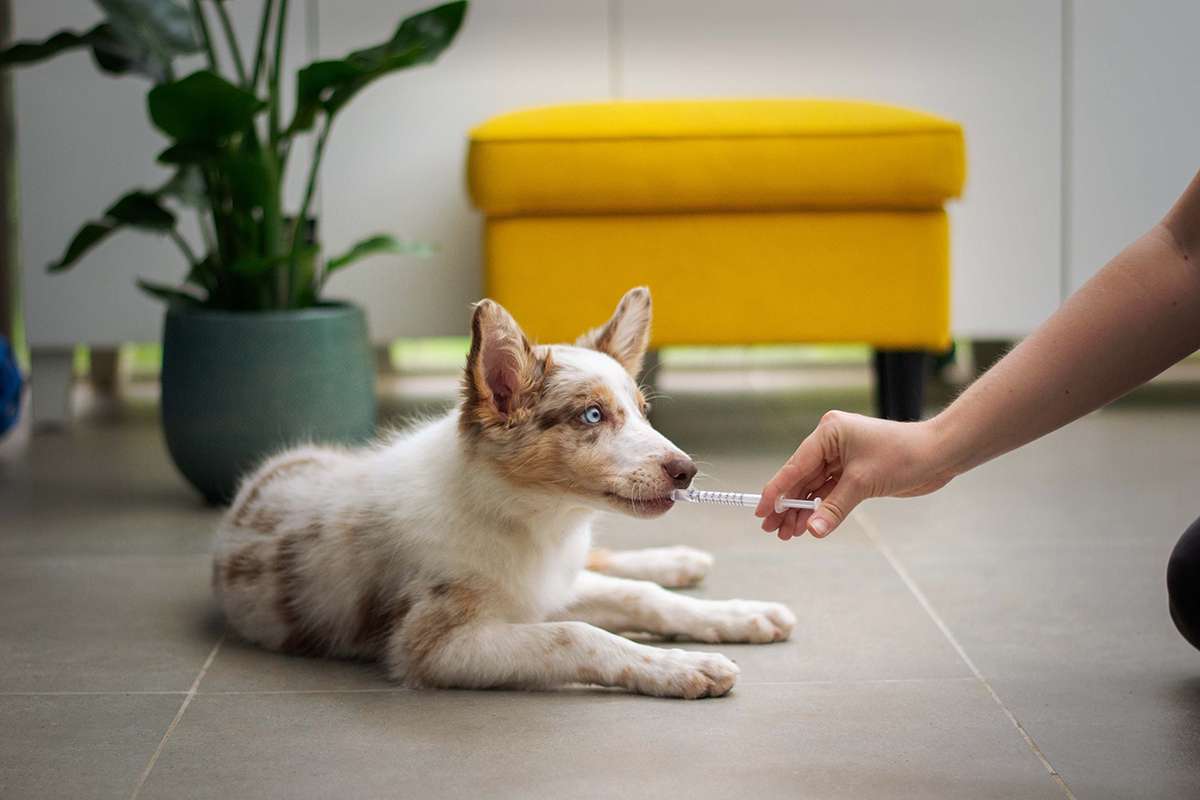Dog can manifest in a variety of ways, such as excessive barking, destructive behavior, and even aggression. If left untreated, anxiety can negatively impact a dog’s quality of life and even lead to serious health problems. Fortunately, there are medications available to help manage anxiety in dogs. In this blog post, we will explore the different types of dog anxiety meds, how they work, and their potential side effects.
Types of Dog Anxiety Meds
Benzodiazepines: Benzodiazepines are a class of drugs that are used to treat anxiety in humans and animals. Examples of benzodiazepines used in dogs include alprazolam (Xanax), lorazepam (Ativan) and diazepam (Valium). Benzodiazepines work by increasing the effects of a neurotransmitter called GABA, which helps to reduce anxiety and promote relaxation. These medications are generally fast-acting and can provide immediate relief for dogs experiencing anxiety, which is why they are often used to treat situational anxiety such as fear of thunderstorms or fireworks. However, they are also associated with a risk of dependence and withdrawal, and they may cause drowsiness and other side effects.
Selective Serotonin Reuptake Inhibitors (SSRIs): SSRIs are a class of drugs that are commonly used to treat anxiety and depression in humans. Examples of SSRIs used in dogs include fluoxetine (Prozac), paroxetine (Paxil) and sertraline (Zoloft). SSRIs work by increasing the availability of serotonin in the brain, which can help to regulate mood and reduce anxiety. Often used to treat separation anxiety, these medications are generally slower-acting than benzodiazepines and may take several weeks to start working. However, they are less likely to cause dependence and withdrawal, and they have fewer side effects.
Tricyclic Antidepressants (TCAs): TCAs are an older class of antidepressant drugs that are sometimes used to treat anxiety in dogs. Examples of TCAs used in dogs include amitriptyline and clomipramine (Clomicalm). TCAs work by increasing the availability of several neurotransmitters, including serotonin and norepinephrine, which can help to regulate mood and reduce anxiety. These medications may take several weeks to start working and can cause side effects such as sedation and dry mouth.
Trazodone: Often used in combination with other medications for dogs with multiple anxiety conditions or for dogs who have not responded to other medications. Trazodone is an antidepressant medication that belongs to the class of drugs known as serotonin antagonist and reuptake inhibitors (SARIs). While it’s primarily used in humans to treat depression, it has gained popularity in veterinary medicine for its anxiolytic (anxiety-reducing) and calming effects.
Gabapentin: Gabapentin is a medication that is commonly used to treat nerve pain and seizures in dogs. It is also sometimes used to treat anxiety. Gabapentin works by increasing the availability of a neurotransmitter called GABA, which can help to reduce anxiety and promote relaxation. Gabapentin may cause side effects such as sedation, ataxia (loss of coordination), and vomiting.
Sileo (dexmedetomidine oromucosal gel): Specifically designed for dogs to treat noise aversions (fear of loud noises, such as fireworks or thunderstorms).
How Dog Anxiety Meds Work
Dog anxiety meds work by altering the levels of neurotransmitters in the brain. Neurotransmitters are chemicals that help to transmit signals between nerve cells. Anxiety is thought to be caused by an imbalance of neurotransmitters, such as a deficiency of GABA or serotonin. By increasing the availability of these neurotransmitters, anxiety meds can help to regulate mood and reduce anxiety.
Side Effects of Dog Anxiety Meds
Like all medications, dog anxiety meds can cause side effects. The specific side effects will depend on the medication and the individual dog. Common side effects of dog anxiety meds include:
Sedation: Many dog anxiety meds can cause sedation, which can make dogs feel drowsy or lethargic. This side effect can be useful for dogs with severe anxiety, as it can help them to relax. However, it can also be problematic if the dog needs to be alert and active.
Loss of coordination: Some dog anxiety meds can cause ataxia, which is a loss of coordination. This side effect can make it difficult for dogs to walk or perform other tasks.
Increased appetite: Some dog anxiety meds can increase appetite, which can lead to weight gain. This side effect can be especially problematic for dogs that are already overweight or prone to obesity.
Dry mouth: Some dog anxiety meds can cause dry mouth, which can make it difficult for dogs to eat and drink normally.
Vomiting: Some dog anxiety meds can cause vomiting or other gastrointestinal upset.
Aggression: In rare cases, dog anxiety meds can cause aggression or other behavioral changes.
It is important to monitor your dog closely for any side effects while they are taking anxiety meds. If you notice any concerning symptoms, you should contact your veterinarian right away.
How to Use Dog Anxiety Meds
Dog anxiety meds should only be used under the guidance of a veterinarian. Your vet will be able to recommend the best medication and dosage for your dog based on their individual needs. They may also recommend other treatments, such as behavioral therapy or environmental modifications, to help manage your dog’s anxiety.
It is important to follow your vet’s instructions carefully when administering anxiety meds. Some medications need to be given with food, while others should be given on an empty stomach. You should also make sure to give the medication at the correct time and in the correct amount. If you miss a dose, do not double up on the medication. Instead, contact your vet for advice on how to proceed.
It is also important to monitor your dog’s response to the medication. If you do not see an improvement in your dog’s anxiety symptoms, or if you notice any concerning side effects, you should contact your vet for guidance.
Dog anxiety can be a challenging issue to manage, but there are medications available that can help. Benzodiazepines, SSRIs, TCAs, and gabapentin are all commonly used to treat anxiety in dogs. These medications work by altering the levels of neurotransmitters in the brain. While anxiety meds can be effective, they can also cause side effects, such as sedation, loss of coordination, and increased appetite. It is important to use dog anxiety meds under the guidance of a veterinarian and to monitor your dog closely for any side effects. With proper management and care, you can help your dog overcome their anxiety and live a happy, healthy life.
Dog Anxiety Meds: Pros and Cons
| PROS: | CONS: |
|---|---|
| Effective Treatment: One of the most significant benefits of dog anxiety meds is their effectiveness in treating anxiety. Anxiety meds work by altering the levels of neurotransmitters in the brain, which can help regulate mood and reduce anxiety. These medications can be especially helpful for dogs with severe anxiety that cannot be managed through behavioral therapy or environmental modifications alone. | Potential Side Effects: One of the most significant downsides of dog anxiety meds is the potential for side effects. Many anxiety meds can cause sedation, loss of coordination, increased appetite, dry mouth, vomiting, and other side effects. Some medications can also cause more serious side effects, such as aggression or other behavioral changes. It is important to monitor your dog closely for any side effects and to contact your veterinarian if you notice any concerning symptoms. |
| Quick Results: Many dog anxiety meds can provide quick relief from anxiety symptoms. Benzodiazepines, for example, can provide immediate relief and can be especially useful in situations where a dog is experiencing acute anxiety, such as during a thunderstorm or fireworks. | Dependency: Some dog anxiety meds, such as benzodiazepines, can cause dependence and withdrawal. This can be especially problematic if a dog needs to stop taking the medication for any reason. It is important to work closely with your veterinarian to ensure that your dog is taking the medication safely and that they are weaned off the medication gradually if necessary. |
| Improved Quality of Life: By reducing anxiety symptoms, dog anxiety meds can help improve a dog’s quality of life. Dogs with anxiety may struggle to engage in normal activities or may experience physical health problems related to their anxiety. Anxiety meds can help dogs feel more comfortable and allow them to enjoy their lives more fully. | Cost: Dog anxiety meds can be expensive, especially if your dog needs to take the medication long-term. This can be a barrier to treatment for some pet owners, as they may not be able to afford the medication or may need to make difficult choices about their pet’s care. |
| Flexible Treatment Options: There are many different types of dog anxiety meds available, which can provide flexibility in treatment. Different medications may be better suited for different types of anxiety, and your veterinarian can help you determine the best medication for your dog based on their individual needs. | Limited Availability: Some dog anxiety meds may not be readily available in all areas. This can make it difficult for pet owners to access the medication that their dog needs. |
Other Considerations
Individual Differences: Just like people, dogs can have individual differences in their response to medication. What works well for one dog may not work as well for another dog. It is important to work closely with your veterinarian to monitor your dog’s response to medication and adjust treatment as needed.
Combined Treatment: In some cases, a combination of medication and other treatments, such as behavioral therapy, may be necessary to effectively manage a dog’s anxiety. It is important to work closely with your veterinarian to develop a comprehensive treatment plan for your dog.
Environmental Modifications: In addition to medication and behavioral therapy, environmental modifications can also be helpful in managing a dog’s anxiety. This can include things like providing a comfortable and secure space for your dog, using calming pheromones, and reducing exposure to triggers that cause anxiety.
Duration of Treatment: The duration of dog anxiety meds treatment will depend on the severity of your dog’s anxiety and their response to treatment. Some dogs may need to take medication long-term, while others may only need medication during specific situations or events.
Safety: It is important to use dog anxiety meds safely and under the guidance of a veterinarian. Some anxiety meds can interact with other medications or medical conditions, so it is important to disclose all relevant information to your veterinarian before starting treatment.
Conclusion
Dog anxiety meds can be an effective tool in managing anxiety in dogs, but they are not without their drawbacks. The potential side effects, cost, and dependency are all important factors to consider when deciding whether to use anxiety meds for your dog. It is important to work closely with your veterinarian to develop a comprehensive treatment plan that takes into account your dog’s individual needs and preferences. With proper management and care, you can help your dog overcome their anxiety and lead a happy, healthy life.
References:




Leave a Reply